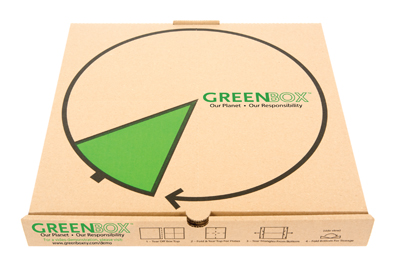
Consider the humble pizza box.
Consider the humble pizza box. Most customers may not spend hours thinking about the simple cardboard vessel used to transport our take-out or delivery pizzas, but there are some who do. Of course, most of these people are in the pizza industry already; the rest are inventors.
 |
|
| The Green Box picked up its first Canadian client.
|
In fact, not one, but two, different groups of contestants have offered up their own versions of 21st century pizza boxes on CBC’s Dragon’s Den. In the third season, an Ontario entrepreneur introduced his idea of a plastic, recyclable take-out/delivery pizza container called the Pizza Pak. He said it was going to revolutionize the pizza industry.
The results weren’t pretty. The inventor was torn to shreds over the idea, into which he’d poured 10 years of sweat equity. The dragons said, among other things, that the Pizza Pak was too expensive per unit, and the good news was he could stop today with the “horrific idea.”
A pair of Windsor, Ont.-area inventors had presented their Pizza Box 2000 a year earlier, and faired a little better. It was a simpler idea involving cardboard, and the hook was that the top of the box could be fashioned into plates. Ultimately, the inventors weren’t given investment money, but viewers acknowledged the potential idea with an online thumbs-up vote.
The idea of a revolutionary pizza box has not died. People are tweaking designs and filing new patents every year. Perhaps the draw is in the numbers.
Late this summer, the New York-based company Environmentally Conscious Organization (the CFO of which is a transplanted Canadian) celebrated its first Canadian sale of their Green Box to Ali Baba Pizza of Victoria, B.C. Like the Pizza Box 2000, the lid of the Green Box tears into plates, but the reusable remainder of the box can easily be sculpted into a more manageable container for leftovers. The box itself is made from recycled material.
“It was actually out of necessity,” says Will Walsh, ECO’s Manhattan-based CEO, of the idea. “In college, we didn’t have any plates in the house; I lived with 30 other guys. We started with just tearing the top off the pizza box off and using it as plates.”
It was at a child’s birthday party, when the host ran out of plates, that other people took notice of Walsh’s box-top plate idea. His low-tech solution was well received and he was encouraged to take it further.
“At that time, I thought removing the box top would make (the rest) useless, and that’s where the real design part came in,” he says. It was also the difference maker: by adding folds to the standard box, customers could halve the box’s size and use it as a fridge friendly cardboard doggy bag.
“I spent a weekend in my apartment trying to figure out something to do with the bottom of the box; not adding more material, making it intuitive and not adding more cost. I did three or four, drew one up and brought it to a patent attorney.”
Upon doing a search, Walsh found there were over 150 pizza box patents already.
Walsh says the response since his first sale – to Arturo’s of Maplewood, N.J.– has been overwhelmingly positive. The chef/owner of Arturo’s, Dan Richer, has even posted a rather passionate four-minute film about using the Green Box on his website (www.arturosnj.com ).
“He built his restaurant, made it totally green,” says Walsh. “He saw the box as a great way to differentiate his product.”
But Walsh says his alternative box isn’t just a simple case of promoting recycling.
“There’s a big debate on whether pizza boxes can be recycled, and it really doesn’t matter. That’s not the issue. The issue is, with our product, you don’t need foil or plastic wrap or plastic bags. Some of that never breaks down … There are 15 square feet of paper that go into a 16-inch box. That’s a lot of paper for a single use.”
Walsh is also counting on a bit of a demographic shift in the pizza business, saying today’s owners are looking for different, more environmentally intelligent products. Of course, cost is important as well.
“The box is very competitively priced. It’s not really any more expensive than other boxes. It’s kind of a no-brainer.”
It was a no-brainer for Mark Murr, the iPad-wielding, app-developing CEO of Victoria’s Ali Baba Pizza, who received his first shipment of Walsh’s boxes in September.
“I saw them at the International Pizza Expo in Las Vegas and loved the idea,” says Murr. He said that he was satisfied with the boxes from China he was using at the time, but he had concerns.
“Green Box is using reputable manufacturers; you’ve got accountability there which is really important. It keeps the money local, in the North American economy, it’s environmentally responsible and I think our customers will really be impressed.”
Use of the Green Box will become part of their advertising too; Murr’s plans include uploading a short film to his website about using the box.
“I definitely feel it’s a huge step for the pizza industry, and for us to be the first, we like to think of ourselves as leaders,” he says.
Back at Green Box headquarters, if things work out, Walsh’s pizza box may even make it to the White House, if it hasn’t already.
It’s rumoured that Obama’s favourite pizza comes from St. Louis, Mo.’s Pi Pizzeria, a company that has started using the boxes themselves.
As it stands, there will be a couple of million Green Boxes sold this year. That does sound impressive, but Walsh would like to sell hundreds of millions. He says that more than 2.25 billion boxes per year are used in the United States alone.
“Our goal,” says Walsh, “is for this to be the standard.”
Print this page